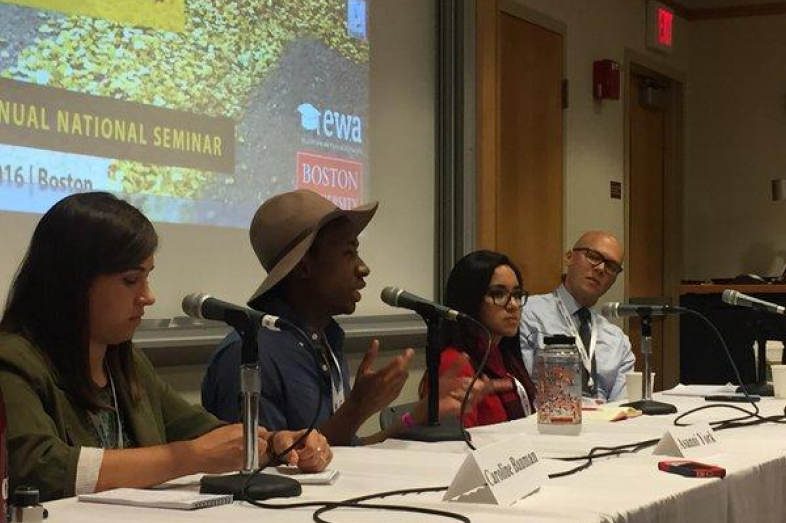

Divisive dialogue erupted last year after students from the University of Missouri formed a wall to prevent reporters from entering a public space — an area that the students who were protesting racism on campus wanted to designate as a “safe space.” But for Mizzou student journalist Caroline Bauman, the incident revealed a disconnect between reporters and the communities they cover.
Speaking in front of dozens education journalists at an Education Writers Association panel in May in Boston about racism on college campuses, Bauman said there’s a nuance to this incident, and others like it, that’s often missed by news outlets.
“I wonder if we could start to have more of a conversation amongst ourselves,” Bauman said, “not [about] whether or not that was an infringement on free speech… Let’s talk about why they felt the need to do that. Why that trust was not there.”
In this case, as in others, national news outlets often “parachute in,” she added, and spend little time trying to understand the historical context around the topical issues they have to cover to feed the 24-7 news cycle. This cycle is especially problematic with sensitive issues like racism.
This focus on immediacy without context has driven a wedge between students and the media, leaving a void in the coverage that leads to speculation and misunderstanding, argued Princeton University junior Asanni York.
“I think a lot of people in the media don’t realize that not only are you in the culture, but you shape the culture, you influence culture,” said York, who is president of Princeton’s Black Student Union and a member of the Black Justice League, the student group that last fall demanded that the Ivy League university improve the racial climate on its campus by removing the name of Woodrow Wilson from the schools and facilities named for him, among other requests.
“What if [media outlets] came together and said, ‘How about we report on this much more slowly,’” he continued. “The first objection to that is, ‘Well media changes too quickly, people don’t care about it.’ People don’t care about it because you give them a new article every day. Maybe if you changed the culture a little bit and moved a little more slowly you would have gotten more interviews out of me and more people.”
Bauman expressed frustration that her own credibility was hurt by journalists who didn’t take the time to understand the history, focusing instead on single issues that don’t require as much explanation and are optimized for quick web hits.
“I think a lot misinformation was able to spread really quickly, and that is really unfortunate and damages journalists’ relationship with people we’re trying to serve on all levels,” she said.
York also expressed frustration that his quotes were often taken out of context. But this concern drew sighs from some in the audience, especially when York described his desire to have larger portions of his statements printed. Freelance journalist Menachem Wecker pointed out a concern that most journalists would have with this idea.
“It’s kind of a bit troubling to sit here and to hear a seemingly unanimous articulation that quality reporting directly correlates to sources feeling happy with the way the story’s been told,” Wecker said, “and also that primarily the reporter is in the source’s court and cares about them rather than pursuing the story.”
Bauman disagreed and said it’s not about making sources happy, but about developing relationships and providing historical context in reporting. Others in the crowd were more sympathetic to Bauman, York, and the other student on the panel, Erendira Calderon, a senior at the University of Illinois at Chicago and member of the Fearless Undocumented Alliance.
Calderon participated in the protest to oppose Donald Trump’s scheduled campaign rally at the UIC Pavilion in March. She said the best media coverage came from outlets that took the time to understand the root of the movement, as opposed to framing it as a reaction to a single event.
PBS NewsHour reporter Kenya Downs asked how the panelists navigate the media’s framing of racial tensions on campus, which often centers on what white people are doing — or not doing – to address something that affects minority populations.
“Largely it comes from asking the right questions,” York said, referring to how journalists’ often reveal the frame of their story through the questions they ask. “Maybe asking what needs to be reported, what I feel about these things, et cetera et cetera. Maybe how other people want this to be viewed, what do you want the larger takeaways to be from these things.”
Black journalists ask different questions, York said, though most journalists are often white men. According to Bauman, that’s part of the problem – many newsrooms don’t reflect the communities they serve. And these disparities can make it tough to establish and build trust.
One person, who identified himself as an editor of a south Texas newspaper, advised outlets to have community advisory boards that reflect the racial makeup of the neighborhoods served.
These boards could serve not as sources for stories, but as a conduit to the community. This way, outlets wouldn’t compromise the necessity of neutrality for the whims of those whom they cover, but they also wouldn’t be detached from the nuance that often shapes public perception.